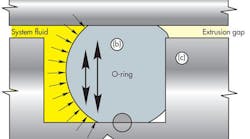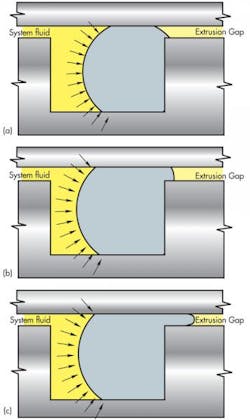Compared to other components in a fluid-power system, the low cost of seals doesn’t earn them much respect. However, rod seals perform one of the toughest jobs in a fluid-power system. They must squeeze the piston rod tight enough to prevent pressurized fluid from leaking out of the cylinder. But if they squeeze too hard, they’ll wear prematurely and maybe even damage the piston rod surface. Not only that, seals must prevent leakage at high pressure, low pressure, varying temperatures, a wide range of rod speeds, and when systems sit idle for days on end.
Effective seals need to perform three basic functions:
Seal — sealing elements must conform closely enough to the microscopic irregularities of the mating surfaces (rod-to-seal groove or piston groove-to-cylinder bore, for example) to prevent pressure fluid penetration or passage (Figure 1);
Adjust to clearance-gap changes — the seal must have sufficient resilience to adjust to changes in the distance between mating surfaces during a cylinder stroke. This clearance gap changes size because of variations in the roundness and diameter of the cylinder parts. The clearance gap also may change size in response to side loads. As the size of the gap changes, the seal must match the size change to maintain compressive sealing force against adjacent mating surfaces; and
Resist extrusion — the seal must resist shear forces that result from the pressure differential between the pressurized and unpressurized sides of the seal. These shear forces attempt to push the elastomeric seal into the clearance gap between adjacent metal surfaces (Figure 2). The seal must have sufficient strength and stiffness to resist becoming deformed into the gap and damaged or destroyed.
Higher pressure improves sealing
High-pressure sealing generally refers to confining fluids at pressures above 5,000 psi. Below these pressures, standard energized urethane lip seals and U-cup seals function well without special provisions. Above them, some sort of special sealing devices are necessary.
Elastomeric materials also must seal while accommodating dimensional variations caused by manufacturing tolerances, side loads, and cylinder deformations under pressure. Understand that in general, sealing improves as fluid pressures increase. System pressure on the seal surface attempts to compress the seal axially. This compression forces the seal more tightly into the gland and helps improve conformability of the seal with its contacting metal surfaces.
If the clearance gap increases during the stroke, resilience of the compressed elastomeric seal causes it to expand radially and maintain sealing force against the metal surfaces. System pressure combines with seal resilience to increase compressive sealing forces when the clearance gap increases. It generally is true that, as system pressure increases, sealing force and the resulting sealing effectiveness also increase if the seal is correctly designed.
The seal’s internal shear stresses increase as system pressure increases. With increasing pressure, the stresses eventually exceed the physical limits of the seal elastomer, and it extrudes into the gap. Difficulties presented by high pressure are not primarily sealing problems, but are problems of keeping the seal in its gland while maintaining its structural integrity as increasing system pressures force the seal into the gap.
Almost all of the design and in-service technology of high-pressure sealing deals with protecting the elastomeric seal from the potentially destructive distortion caused by high system pressures. With proper backup to reduce the size of the gap, relatively fragile elastomers can successfully seal extremely high pressures.
When handling a 90-durometer energized urethane lip seal or U-cup at room temperature, the seal seems to be made of an extraordinarily stiff, tenacious material. It requires well-designed experiments and/or sophisticated computer simulations to visualize the state of such a seal inside a hydraulic cylinder at normal operating temperatures and pressures. At pressures as low as 600 psi for 70-durometer nitrile rubber and 1,500 psi for 90-durometer urethane, the seal cross section is significantly deformed. It changes shape almost instantaneously in response to pressure spikes or changes in the size of the clearance gap.
Material is the key
The key to high-pressure sealing is the use of a material or a combination of materials that has sufficient tear strength, hardness, and modulus to prevent extrusion through the gap. At pressures of 5,000 to 7,000 psi, the strongest elastomeric materials in standard seal configurations resist the extrusion without reinforcement. At higher pressures, the elastomeric sealing element must be backed by a higher modulus and harder material. Various more-or-less standard backup configurations have demonstrated their effectiveness over many years.
At pressures in excess of 20,000 psi, the extrusion gap must be closed and the elastomeric seal must be protected by a sequence of progressively harder, higher-modulus materials. Properly designed, this progression of materials prevents extrusion, tearing, cutting, or other destructive deformation of the elastomeric seal and distributes loads more uniformly to the element that bridges the gap.
Recent developments
In Europe and the United States, as the move to more environmentally friendly fluids grows, many types of vegetable-based and synthetic oils have been developed. Each has its own set of characteristics — many of which can affect sealing effectiveness seal material compatibility.
The seal industry has kept up with the technology by introducing new materials and blends to accommodate chemical and physical properties of these new fluids while still providing the sealing integrity users expect.
Material for this article was excerpted from the Fluid Power Handbook & Directory, which can be accessed from our home page by clicking on the Fluid Power Basics button.



